By Atala Dorothy Toy
Originally printed in the NOVEMBER-DECEMBER 2008 issue of Quest magazine.
Citation: Toy, Atala Dorothy. "Going Around in Circles: The Labyrinths of Theosophy." Quest 96.6 (NOVEMBER-DECEMBER 2008):219-225.
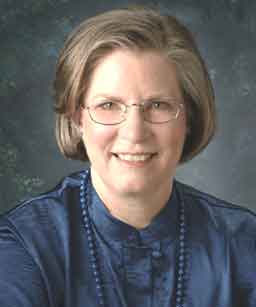 THE LABYRINTH PATH THAT IS THE PATH is not the path," a Taoist might observe when walking the continually reversing circuits of a labyrinth.
THE LABYRINTH PATH THAT IS THE PATH is not the path," a Taoist might observe when walking the continually reversing circuits of a labyrinth.
For over 5000 years, the same classical labyrinth pattern has been used for purposes as diverse as creating a town's fortification system, drawing water to arid land, enhancing a meditative focus on one's spiritual life, and balancing the brains of bipolar children. Still, no matter how many times a person walks even the same labyrinth; it is always a new experience.
Labyrinths are ancient energy grids that have waxed and waned in popularity over the centuries. They have appeared on ancient temple walls, pottery, and floors, as the basis for battle plans and fortifications, and as patterns that have been integrated with the landscape to form powerful and energy-rich locations.
In 2001 a group of enthusiasts met in Atlanta, Georgia, and formed the Labyrinth Society. They immediately began a group project of precisely defining the many ambiguous terms historically associated with this figure. The society's definition of a labyrinth (found on its Web site, www.labyrinthsociety.org ) is "a single path or unicursal tool for personal, psychological and spiritual transformation. Labyrinths are thought to enhance right brain activity." Each single round of a labyrinth is called a circuit.
The society's Web site distinguishes labyrinths from mazes in that "a maze can have more than one entrance and numerous choices along the way. The walls are usually high so as to block one from seeing the way out. It is constructed to be a left-brain puzzle." A maze, by its very nature, delights in confusing the path to the truth, forcing an individual to creatively look at and choose from many paths, some of which go nowhere at all!
A labyrinth, by contrast, is a sacred site that gently and inexorably guides one not only to the source, but also back out to the world. Each labyrinth takes on a certain spirit, which comes from the activities that take place on the pattern as well as from the site itself. A labyrinth continually walked by patients at a hospital will develop a different kind of energy from that of one walked by seekers at a quiet spiritual retreat.
During a walk on a labyrinth, which typically takes about twenty minutes to complete, "the mind quiets, the breath slows, and time stretches out. The labyrinth can be used as a path for prayer and meditation," according to the Labyrinth Society's Web site. "It can also be used as a tool of discernment by considering your experiences on the metaphorical level." Depending upon one's orientation and needs, walking a labyrinth can take one on a journey through the astrological realms, the personal transformation of issues, the musical octave, the rainbow of colors, the seven chakras, physiological and mental rebalancing, or silent meditative centering. It can also be a simple joyful romp.
A labyrinth can be left-handed or right-handed. Its orientation is determined by the direction of the first turn after the entrance. Left-handed labyrinths are more intuitive in frequency, while right-handed ones are more outwardly oriented. Jeff Saward, an international labyrinth historian, estimates that approximately two-thirds of the ancient classical labyrinths are right-handed and two-thirds of the modern classical ones are left-handed. The reason for this has not been ascertained, although it is very likely connected to a balancing of energy for that particular time. Thus, ancient people were focused more on stabilizing energy for use on a physical level (such as a city,s fortification), while modern walkers are more often seeking access to spirit. The Theosophical Society's labyrinths are all left-handed.
Labyrinth Patterns
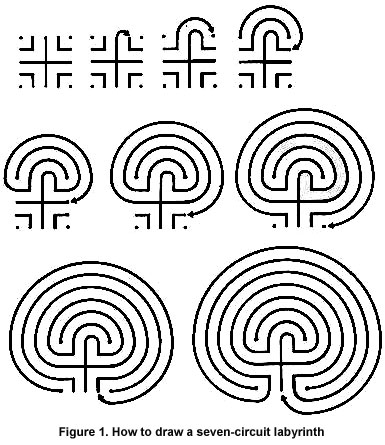 Labyrinths come in different patterns. One of the most ancient and most common, the classical labyrinth, has been found on walls, pottery, and coins going back thousands of years. It is associated with nature traditions, and its basic construction is based on a seed pattern that grows out in an organic manner (figure 1).
Labyrinths come in different patterns. One of the most ancient and most common, the classical labyrinth, has been found on walls, pottery, and coins going back thousands of years. It is associated with nature traditions, and its basic construction is based on a seed pattern that grows out in an organic manner (figure 1).
The entry door for the classical labyrinth can originate from any direction and is often determined by the energies of the site. Placement of the classical labyrinth is usually done by dowsing and asking the land itself various questions, including: Is it appropriate for the labyrinth to be located here? Is a certain design appropriate? Where should the center be? What size should it be? What direction should it face? Are there other features that should be included? For many classical labyrinth builders, the power of this form comes from the earth and from the mechanics of its interface with the earth energies of that location.
Included in this category is the meander, based on the Greek key pattern. While this square pattern appears to "meander" along a linear path, its basic form has been shown to evolve into that of the round classical labyrinth. The Roman labyrinth is a classical variation: square, round, or polygonal in shape and often used on floors, perhaps originating as a means of energy stabilization and protection for that area. There is also a three-dimensional classical labyrinth, which occurs when the pattern is adjusted around the specific topography of a site. One of the most famous of these sites is Glastonbury Tor in England, a very high-energy sacred site that has a seven-circuit labyrinth cascading down its sides. Builders will sometimes construct a topographical labyrinth around a tree or boulder or to fit a specific site configuration. It is an excellent way to rebalance energy on any piece of property.
The pattern of the classical labyrinth looks like the brain, and walking it is a dance with the forces of the universe. Just as in life, the goal is to reach the central source, but the path to it takes one close and far away by turns, until finally, the center is attained. At this point, the seeker realizes that his journey is only half done, for now he must dance the energy of the source back out to the world.
Another name for the classical labyrinth is the Cretan labyrinth, from its association with Crete and the Minotaur. In this Greek myth, the Minotaur, a monster that was half-bull and half-man, lived in the middle of a maze—shown on ancient Cretan coins to be a classical labyrinth in design. Young Athenian men and women were sacrificed to the Minotaur until the hero Theseus, assisted by Ariadne, daughter of King Minos of Crete, finally killed the bull. The Cretans, who were at that time (the middle of the second millennium BC) a powerful nation, used labyrinthine forms throughout their art, architecture, and fortifications.
The classical labyrinth's effectiveness in controlling and protecting goes back thousands of years. It has been depicted in ancient texts describing the fabled military wheel offensive of the Kauravas in the battle of Kurukshetra as described in the Mahabharata. Interestingly, these diagrams show a right-handed entrance. Other ancient texts depict the famous Trojan wall defenses in the form of a classical labyrinth. This defensive pattern was exported to towns throughout the Mediterranean and up into the British Isles. A town using this pattern was often called "Troy Town" in the local language.
In modern times, the classical labyrinth is sometimes overlaid with a medicine wheel, so that the individual is not only walking into the circle but is also aware of the cyclical changes that occur as he or she traverses each circuit.
The Tohono O'odham Indians of Arizona have as a part of their spiritual tradition a pattern called the "Man in the Maze." A classical-style labyrinth, this image signifies the journey each person must take through the twists and turns, difficulties and opportunities of life.
Runic labyrinths have come into use over the past twenty years. In this system, each circuit is dowsed for the rune energy manifested at specific spots and a glyph is embedded at that location. As someone walks the labyrinth, he or she pauses at each location, merges with that particular rune energy, and then moves on.
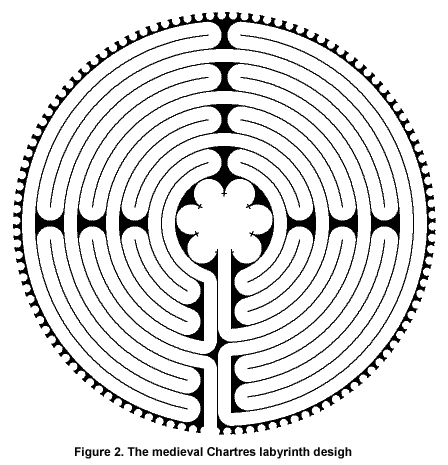 The medieval labyrinth evolved during the early Middle Ages as a church design and is set up using sacred geometry; it is usually charted and then applied to a site. It is sometimes called the Chartres labyrinth, because the design appears on the floor of this French cathedral. The medieval labyrinth is totally round and divides into four equal-sized quadrants that together form a cross. Its power comes from the act of walking it as a metaphysical journey of contemplation on Christ consciousness. The medieval labyrinth is usually entered on the west, so that the individual starts by facing east, the site of the rising sun (the risen Son). A medieval labyrinth has a more specific focus on theology: it is considered by its advocates to be a form of body prayer or walking prayer that is leading the walker to God (figure 2).
The medieval labyrinth evolved during the early Middle Ages as a church design and is set up using sacred geometry; it is usually charted and then applied to a site. It is sometimes called the Chartres labyrinth, because the design appears on the floor of this French cathedral. The medieval labyrinth is totally round and divides into four equal-sized quadrants that together form a cross. Its power comes from the act of walking it as a metaphysical journey of contemplation on Christ consciousness. The medieval labyrinth is usually entered on the west, so that the individual starts by facing east, the site of the rising sun (the risen Son). A medieval labyrinth has a more specific focus on theology: it is considered by its advocates to be a form of body prayer or walking prayer that is leading the walker to God (figure 2).
There are also free-form labyrinths, created by individuals using unique plans and united only in their definition as "unicursal labyrinthine pathways or multiple paths designed not to confuse, but to enhance spiritual perception or peaceful energies." These are often labyrinths designed to fit into an unusual piece of property or to function as art pieces.
Walking the Path
Why walk a labyrinth? As with all great forms of wisdom, the answer is simple. The reasons why may fill volumes. Labyrinths have generated hundreds of tomes explaining this pattern's endlessly intriguing nature and inherent value.
Traveling the seven-circuit classical labyrinth as a journey through the chakras is extremely powerful (figure 3). In the diagram shown here, you can see that the seven circuits are numbered from the outside in sequence. This correlates to the seven chakras:
1. Base chakra. Your relationship to the universe
2. Sacral chakra. Your relationship to the community in which you exist
3. Solar plexus. Your perception of yourself
4. Heart. The point of oneness in the human body with the all; the balance between the lower and higher chakras
5. Throat. How you speak your truth
6. Third Eye. How you see the truth
7. Crown. Your spiritual relation to the universe
In addition, there are two other levels:
8. The Source itself
9. The outside world in which the labyrinth, or individual, resides
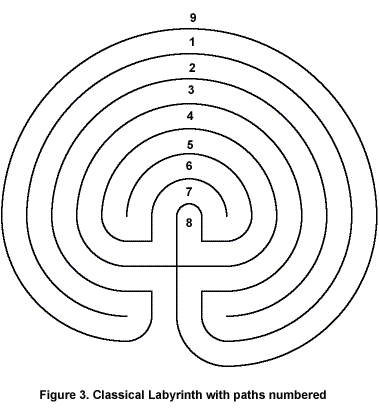 When you walk the labyrinth, you are actually walking the circuits in the following sequence: 3—2—1—4—7—6—5—8. This is as you go in. When you exit, you do so in reverse: 8—5—6—7—4—1—2—3 and then you emerge via the "birth canal" into the outside world.
When you walk the labyrinth, you are actually walking the circuits in the following sequence: 3—2—1—4—7—6—5—8. This is as you go in. When you exit, you do so in reverse: 8—5—6—7—4—1—2—3 and then you emerge via the "birth canal" into the outside world.
The walk through the seven circuits is seen as the journey to self-realization. You enter through the solar plexus (3), asking the question "Who am I?", and then proceed to define yourself according to your community (2) and the world (1) before realizing that the answer is actually inside yourself and you focus on the heart (4). The heart tells you that the answer is in spirit, and so you attempt to travel to source, getting as far as the crown chakra (7). But here you realize that the answer is more complex than it seemed at first and you travel next into the third eye for wisdom (6), and into the throat chakra to find a way to express what you have experienced (5). Only then are you fully prepared to enter the one source of all (8).
Now that you are centered in the source and gazing out, you realize you are only halfway through your journey. Once you have acquired this knowledge of source, you are obliged to return by way of the same paths of energy to bring this message to the world (9).
An astrological understanding of the labyrinths is favored by John Algeo, international vice-president of the Theosophical Society (see Explorations in the January-February 2001 Quest). Algeo describes the significance of each circuit in this manner, along with the planets and the days of the week traditionally associated with them:
3. Mars. Desire, Tuesday
2. Jupiter. Self-identity, Thursday
1. Saturn. Empirical mind, Saturday
4. Sun. Vitality, Sunday
7. Moon. Form, Monday
6. Mercury. Intuition, Wednesday
5. Venus. Pure mind, Friday
Algeo has also related the seven circuits to the seven principles in Theosophy. As quoted in an article in The American Theosophist describing Algeo's 1995 workshop at Stil-Light in 1995, this pairing relates, for instance, "Mars to passion (kama), Venus to intuition (buddhi-manas), the Moon to the etheric (linga-sharira) and Saturn to lower mind (kama-manas)." (See Lewis Lucas, "The Labyrinth at Stil-Light," The American Theosophist, early winter 1995, p. 11.)
Prayers for Problem Solving
In his book Labyrinths, Sig Lonegren provides many ways to build and work with this land energy form. He offers an explanation of how to walk a labyrinth to solve personal problems. It is similar to walking the chakras, in this case focusing on a specific issue you wish to have clarified as you traverse the world of energy.
Some free spirits who are loath to be penned in by any explanation prefer just to walk the labyrinth and experience it. Robert Ferre, a well-known labyrinth builder, refers to this as "taking a stroll with your soul." He observes that the movement of energy through a human and through nature is circular in form, just like a labyrinth. He recommends that people simply ask a question and walk. Just walk: be patient, quiet, attentive, open, and not insistent. You cannot force an answer; it needs to simply descend into your awareness.
Children often consider the labyrinth to be a game and run one for the simple joy of running. Adults often find it extremely liberating to run it themselves.
You can also dance the labyrinth with a partner. Dancing the labyrinth is an ancient ritual. Sometimes called the Crane Dance, it was performed in pagan circles as an entrance to spring or to symbolize the reemergence of life after the death of winter. This dance was at one time extremely popular, as can be deduced by the numerous edicts of the medieval church forbidding the performance of the dance on church labyrinths.
About a decade ago, labyrinth enthusiast John Appleton observed that two people could traverse much of a labyrinth while holding hands. Nowadays, at labyrinth gatherings, the Appleton Dance is sometimes performed as an enjoyable social experience and sometimes as a profound experience of the partnership of all life forms in the universe.
During much of the middle part of the labyrinth journey, two people can walk together. But at the start and the end, each person must go alone. To perform this dance:
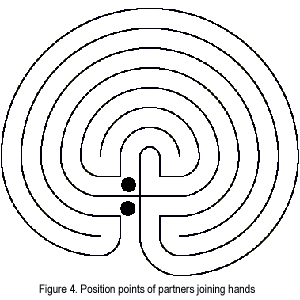 The partners (or a group of people) determine an issue or energy they wish to work on together. While one stands at the entrance of the labyrinth, another carries the issue to spirit, depositing it in the source and asking spirit for the appropriate consciousness to bring back out. As this person returns, he travels down to express the new consciousness through the crown chakra (7), third eye (6), and throat (5) before coming to the heart (4), demonstrating that communication requires working with others. At this point he joins hands with his partner, who is waiting at the start of her own path to self-awareness (3). The two share energy until they finally separate, the second person moving into the source on her own and the other exiting the labyrinth to offer the message to the entire outer world. On exiting, the second person can complete the walk on her own, or share in a similar way with the next person in line (figure 4).
The partners (or a group of people) determine an issue or energy they wish to work on together. While one stands at the entrance of the labyrinth, another carries the issue to spirit, depositing it in the source and asking spirit for the appropriate consciousness to bring back out. As this person returns, he travels down to express the new consciousness through the crown chakra (7), third eye (6), and throat (5) before coming to the heart (4), demonstrating that communication requires working with others. At this point he joins hands with his partner, who is waiting at the start of her own path to self-awareness (3). The two share energy until they finally separate, the second person moving into the source on her own and the other exiting the labyrinth to offer the message to the entire outer world. On exiting, the second person can complete the walk on her own, or share in a similar way with the next person in line (figure 4).
Physiology and Earth Balancing
A good deal of work is being done today in under-standing the physiological benefits of labyrinth walking. This has occurred as a result of the observations of facilitators who find that adults and children with learning disabilities often emerge from the labyrinth with at least a temporary improvement in their cognitive abilities. This observation has engendered a number of medically oriented studies. It is currently understood that the many left-to-right and right-to-left turns experienced while walking the labyrinth causes a vestibular response that temporarily balances the logical and artistic activities of the brain. In lay terms, it causes brain fluid to move back and forth across the middle line of the brain, helping to balance and integrate the different capacities of the right and left sides of the brain. This integration remains for a time after the individual emerges from the labyrinth. Sometimes, when the labyrinth is walked continuously, these benefits become more permanent. For this reason, as well as for the peace that is engendered, a number of hospitals around the country have installed labyrinths on their grounds.
Walking is an essential part of this healing process, since the body is a processing plant and synthesizes and grounds what the head can only conjecture. When someone cannot walk the labyrinth on her own, placing her on a horse and having the horse traverse the labyrinth can also have profoundly beneficial results. In this case, one is combining the known therapeutic energy of the horse with that of the labyrinth. Some therapists are working with horses and labyrinths to assist learning-disabled children and children with bipolar issues, dyslexia, attention deficit disorder (ADD), and attention deficit hyperactivity disorder (ADHD). In this case, a specially constructed labyrinth is used, with circuit paths from three feet to eight feet in width so that a horse can navigate it. A therapist often walks beside the patient.
Dowsers, those formidable individuals who use rods and pendulums to detect and affect energy, often incorporate labyrinths into their work to change, alleviate, enhance, and hold beneficial energies for a piece of land or for Earth herself. Water domes and flows are often charted as emerging from labyrinths, and this engenders the classic question: which came first? The labyrinth form has a way of calling up and holding energy in an area, and one often finds cows, sheep, and other animals grazing or resting on a labyrinth. The classical labyrinth has been found among the giant Nazca Lines in Peru. These mysterious diagrams have been conjectured to fill many purposes, among them serving as a means to draw water to that high, inaccessible, arid region.
Theosophical Labyrinths
Four Theosophical centers in America offer classical-style labyrinths. The labyrinths serve their local communities and also help connect the retreat centers to the unified field of consciousness that the Theosophical Society embodies.
Beginning in 1995, John Algeo, at that time president of the Theosophical Society in America, began offering lectures on the value of the labyrinth for the spiritual life including a talk at the 1998 Inter-American Theosophical Federation Meeting, "The Labyrinth of Life," and in 2001, he wrote "The Labyrinth: A Brief Introduction to its History, Meaning and Use" for Quest magazine. That summer, Algeo and Diana March participated in a retreat at Stil-Light Theosophical Center in North Carolina, where they led a workshop in which participants laid out and constructed a stone labyrinth. (Unfortunately, Stil-Light is no longer operative as a Theosophical center.) Since then, Algeo and March have each hosted lectures and workshops on the value of the labyrinth at regional and national gatherings.
All of the Theosophical labyrinths are of the seven-circuit classical style and are in continual use by many people in their areas. But here the similarities end, for each labyrinth is made of different materials and has been integrated into its area's landscape in its own unique manner. Each is a cooperative work in progress, a joint partnership among the land, the spirits of the land, the energies of the TS, and the people who walk at that location.

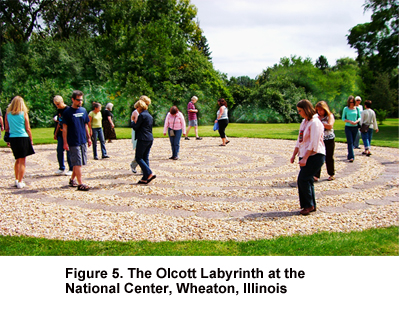 The best known of the Theosophical labyrinths is the Olcott Labyrinth at the Society's American headquarters in Wheaton, Illinois . The Olcott labyrinth is highly regarded by enthusiasts and is listed in the worldwide labyrinth locator maintained by the Labyrinth Society. Fifty feet in diameter, it is constructed of circular paving stones set in a field of sand-washed pebbles and is set in an open grass lawn to the west of the L. W. Rogers Building. Its mouth is to the north. The building of the labyrinth was implemented by John Algeo during his term as national president. Neil Harris assisted in siting the labyrinth and Dan Doolin was responsible for directing the grounds department in excavating and building the foundation. Overseen by Diana March, the Young Theosophists, organized by Joan McDougall, donated the labor for the laying of the labyrinth pattern in concrete pavers with surrounding stone pebbles.
The best known of the Theosophical labyrinths is the Olcott Labyrinth at the Society's American headquarters in Wheaton, Illinois . The Olcott labyrinth is highly regarded by enthusiasts and is listed in the worldwide labyrinth locator maintained by the Labyrinth Society. Fifty feet in diameter, it is constructed of circular paving stones set in a field of sand-washed pebbles and is set in an open grass lawn to the west of the L. W. Rogers Building. Its mouth is to the north. The building of the labyrinth was implemented by John Algeo during his term as national president. Neil Harris assisted in siting the labyrinth and Dan Doolin was responsible for directing the grounds department in excavating and building the foundation. Overseen by Diana March, the Young Theosophists, organized by Joan McDougall, donated the labor for the laying of the labyrinth pattern in concrete pavers with surrounding stone pebbles.
In recent years, the TS has hosted an annual spring equinox labyrinth walk at the Olcott Labyrinth for its members and the public. Other regional retreat centers hold occasional formal events around their labyrinths, and all the labyrinths are generally open to the public during daylight hours (figure 5).
The other TS labyrinths may be found at:
Pumpkin Hollow Retreat Center, Craryville. New York. Located in the heart of the Adirondacks, this labyrinth is thirty-three feet in diameter with an eastern entrance. It was constructed during a labyrinth workshop in June 1996 from the quartz stones that abound in that area. When its builders were planning the labyrinth, they queried the earth energies, who chose, not the nearby site its human designers wanted, but one located a good twelve-minute walk away on a quiet, wooded rise at the far end of the property. Visitors often carry quartz stones and add them to help build up the labyrinth lines. Wildflowers grow among the stones, further outlining the circuits (figure 6).
Krotona School of Theosophy, Ojai, California. Diana March provided plans for the Krotona Labyrinth, which was constructed in 1997 as part of a workshop led by John Algeo. This labyrinth is thirty-nine feet in diameter. It has an entrance on the west and is located in an open meadow next to the Krotona School, with a view of the surrounding mountains. Originally laid out with powdered chalk, it has gradually been filled in with stones placed by walkers.
Camp Indralaya, Orcas Island, Washington state. Diana March traveled to Washington state in April 1999 to lead a labyrinth work-shop at Camp Indralaya. This labyrinth, twenty-eight feet in diameter, was built with materials local to that site: stones, shells, and driftwood (figure 8). It is located on a lawn just behind and below (north of) the main dining hall. The lawn is on a bluff above Judd Cove, which is part of a larger body of water called East Sound.
References
Conty, Patrick. The Genesis and Geometry of the Labyrinth. Rochester, Vt.: Inner Traditions, 2002.
Ferre, Robert. Constructing Classical Labyrinths. St. Louis, Mo.: Labyrinth Enterprises, 2002.
———”. Church Labyrinths. St. Louis, Mo.: One Way Press, 2001.
Lonegren, Sig. Labyrinths. New York: Sterling, 2001.
Atala Dorothy Toy is president of Crystal Life Technology Inc., a St. Charles, Illinois, company that supplies esoteric, environmental, and dowsing products and information through its store and Web site (www.crystal-life.com ). Atala is secretary of the Board of Trustees of the American Society of Dowsers and cofounder of the Institute for the Study of Interdimensional Cooperation. She is a member of the Labyrinth Society and the Theosophical Society and leads an annual spring equinox walk on the Olcott Labyrinth. Her book, How to Talk with Trees (Red Wheel/Weiser/Conari), is due in bookstores next summer.
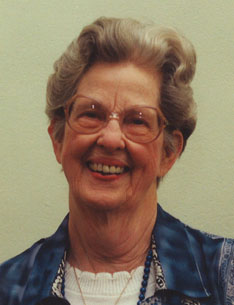


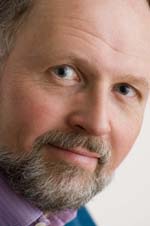
 THE LABYRINTH PATH THAT IS THE PATH is not the path," a Taoist might observe when walking the continually reversing circuits of a labyrinth.
THE LABYRINTH PATH THAT IS THE PATH is not the path," a Taoist might observe when walking the continually reversing circuits of a labyrinth. Labyrinths come in different patterns. One of the most ancient and most common, the classical labyrinth, has been found on walls, pottery, and coins going back thousands of years. It is associated with nature traditions, and its basic construction is based on a seed pattern that grows out in an organic manner (figure 1).
Labyrinths come in different patterns. One of the most ancient and most common, the classical labyrinth, has been found on walls, pottery, and coins going back thousands of years. It is associated with nature traditions, and its basic construction is based on a seed pattern that grows out in an organic manner (figure 1). The medieval labyrinth evolved during the early Middle Ages as a church design and is set up using sacred geometry; it is usually charted and then applied to a site. It is sometimes called the Chartres labyrinth, because the design appears on the floor of this French cathedral. The medieval labyrinth is totally round and divides into four equal-sized quadrants that together form a cross. Its power comes from the act of walking it as a metaphysical journey of contemplation on Christ consciousness. The medieval labyrinth is usually entered on the west, so that the individual starts by facing east, the site of the rising sun (the risen Son). A medieval labyrinth has a more specific focus on theology: it is considered by its advocates to be a form of body prayer or walking prayer that is leading the walker to God (figure 2).
The medieval labyrinth evolved during the early Middle Ages as a church design and is set up using sacred geometry; it is usually charted and then applied to a site. It is sometimes called the Chartres labyrinth, because the design appears on the floor of this French cathedral. The medieval labyrinth is totally round and divides into four equal-sized quadrants that together form a cross. Its power comes from the act of walking it as a metaphysical journey of contemplation on Christ consciousness. The medieval labyrinth is usually entered on the west, so that the individual starts by facing east, the site of the rising sun (the risen Son). A medieval labyrinth has a more specific focus on theology: it is considered by its advocates to be a form of body prayer or walking prayer that is leading the walker to God (figure 2). When you walk the labyrinth, you are actually walking the circuits in the following sequence: 3
When you walk the labyrinth, you are actually walking the circuits in the following sequence: 3 The partners (or a group of people) determine an issue or energy they wish to work on together. While one stands at the entrance of the labyrinth, another carries the issue to spirit, depositing it in the source and asking spirit for the appropriate consciousness to bring back out. As this person returns, he travels down to express the new consciousness through the crown chakra (7), third eye (6), and throat (5) before coming to the heart (4), demonstrating that communication requires working with others. At this point he joins hands with his partner, who is waiting at the start of her own path to self-awareness (3). The two share energy until they finally separate, the second person moving into the source on her own and the other exiting the labyrinth to offer the message to the entire outer world. On exiting, the second person can complete the walk on her own, or share in a similar way with the next person in line (figure 4).
The partners (or a group of people) determine an issue or energy they wish to work on together. While one stands at the entrance of the labyrinth, another carries the issue to spirit, depositing it in the source and asking spirit for the appropriate consciousness to bring back out. As this person returns, he travels down to express the new consciousness through the crown chakra (7), third eye (6), and throat (5) before coming to the heart (4), demonstrating that communication requires working with others. At this point he joins hands with his partner, who is waiting at the start of her own path to self-awareness (3). The two share energy until they finally separate, the second person moving into the source on her own and the other exiting the labyrinth to offer the message to the entire outer world. On exiting, the second person can complete the walk on her own, or share in a similar way with the next person in line (figure 4).  The best known of the Theosophical labyrinths is the Olcott Labyrinth at the Society's American headquarters in Wheaton, Illinois . The Olcott labyrinth is highly regarded by enthusiasts and is listed in the worldwide labyrinth locator maintained by the Labyrinth Society. Fifty feet in diameter, it is constructed of circular paving stones set in a field of sand-washed pebbles and is set in an open grass lawn to the west of the L. W. Rogers Building. Its mouth is to the north. The building of the labyrinth was implemented by John Algeo during his term as national president. Neil Harris assisted in siting the labyrinth and Dan Doolin was responsible for directing the grounds department in excavating and building the foundation. Overseen by Diana March, the Young Theosophists, organized by Joan McDougall, donated the labor for the laying of the labyrinth pattern in concrete pavers with surrounding stone pebbles.
The best known of the Theosophical labyrinths is the Olcott Labyrinth at the Society's American headquarters in Wheaton, Illinois . The Olcott labyrinth is highly regarded by enthusiasts and is listed in the worldwide labyrinth locator maintained by the Labyrinth Society. Fifty feet in diameter, it is constructed of circular paving stones set in a field of sand-washed pebbles and is set in an open grass lawn to the west of the L. W. Rogers Building. Its mouth is to the north. The building of the labyrinth was implemented by John Algeo during his term as national president. Neil Harris assisted in siting the labyrinth and Dan Doolin was responsible for directing the grounds department in excavating and building the foundation. Overseen by Diana March, the Young Theosophists, organized by Joan McDougall, donated the labor for the laying of the labyrinth pattern in concrete pavers with surrounding stone pebbles.